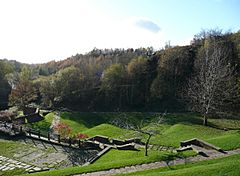Park Bridge facts for kids
Quick facts for kids Park Bridge |
|
|---|---|
 View of Park Bridge from the ironworks |
|
| OS grid reference | SD9402 |
| Metropolitan borough | |
| Metropolitan county | |
| Region | |
| Country | England |
| Sovereign state | United Kingdom |
| Post town | ASHTON-UNDER-LYNE |
| Postcode district | OL |
| Dialling code | 0161 |
| Police | Greater Manchester |
| Fire | Greater Manchester |
| Ambulance | North West |
| EU Parliament | North West England |
| UK Parliament |
|
Park Bridge is a small area in Ashton-under-Lyne, Greater Manchester, England. It is part of the Metropolitan Borough of Tameside. This area is located in the Medlock Valley, near the border with Oldham.
The name "Park Bridge" likely comes from the old Lyme Park. This park was in the northwest part of the Ashton area during medieval times. For almost 200 years, from the 1700s to the 1900s, Park Bridge was home to a very important factory called the Park Bridge Ironworks.
Contents
History of Park Bridge
The Ironworks Begins
The Park Bridge Ironworks was started in 1786 by Samuel Lees junior. He rented a small piece of land from the Earl of Stamford to build his factory. At first, the ironworks made raw iron. It became one of the biggest iron factories in the northwest of England during the 1800s. It was also one of the first ironworks in the region.
When Samuel Lees died in 1804, his wife, Hannah Lees, took over the business. Under her leadership, the ironworks grew even more. They built a weir and a water power building on the River Medlock. This helped the factory run better.
Growing the Community
Because the ironworks was so successful, homes were built for the workers. These houses were added in the 1820s, and more were built in the 1840s and 1850s. The ironworks stayed the largest in the Tameside area. It even had its own coal mine nearby. It was also connected to the Oldham, Ashton and Guide Bridge Railway.
The Lees family continued to own and run the ironworks for four more generations. They kept the business going until it finally closed down.
The End of an Era
The ironworks started to slow down in the late 1800s. This happened when coal mining stopped in the Medlock Valley in 1887. Also, new steel factories became very popular. This made it harder for the ironworks to make money. When the railway closed in 1959, it hurt the business even more.
The Park Bridge Ironworks finally closed its doors in 1963. It was still owned by the Lees family at that time.
What Happened Next?
After the ironworks closed, the buildings were left empty. They started to fall apart. In the 1970s, most of the old factory was torn down. Because no one had recorded the buildings before they were demolished, the site became very interesting to archaeologists. These are people who study old places and objects. The University of Manchester Archaeological Unit has studied the site. They want to learn more about how the iron industry grew in the northwest.
In 1975, a group called the Medlock and Tame Valley Conservation Association opened the Park Bridge Museum. They wanted to teach people about the important history of Park Bridge. In 1986, the museum became a visitor centre. Then, in 1995, it was renamed the Park Bridge Heritage Centre. As of 2025, you can visit the centre by making an appointment. It is not generally open to the public every day.
Famous Connections
The ironworks at Park Bridge made rivets that were used all over the world. Rivets are like strong metal pins used to hold things together. Did you know that the famous Eiffel Tower in Paris used rivets from Park Bridge? Even the Titanic ship, which was built a long time ago, used rivets made at this factory!
Images for kids
See also
- Park Bridge railway station






